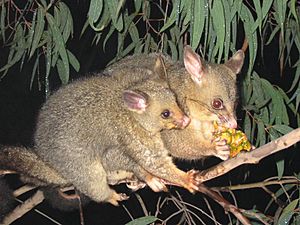Phalangeridae facts for kids
Quick facts for kids Phalangeridae |
|
|---|---|
 |
|
| Common brushtail possum | |
| Scientific classification |
|
| Kingdom: | Animalia |
| Phylum: | Chordata |
| Class: | Mammalia |
| Infraclass: | Marsupialia |
| Order: | Diprotodontia |
| Superfamily: | Phalangeroidea |
| Family: | Phalangeridae |
| Genera | |
|
|
The Phalangeridae are a family of marsupials. These are animals that carry their young in a pouch. Most phalangerids are active at night, meaning they are nocturnal.
You can find these animals in Australia, New Guinea, and parts of Eastern Indonesia. This family includes animals like cuscuses and brushtail possums. Most species live in trees, which means they are arboreal. They live in many types of forests, from cool mountain woodlands to tropical jungles. Humans have also moved many of these animals to new places over thousands of years.
Contents
What Makes Them Special?
Phalangerids are quite large compared to other possums. The smallest one, the Sulawesi dwarf cuscus, is about the size of a cat, around 34 cm long. The biggest, the black-spotted cuscus, can be about 70 cm long and weigh 5 kg.
One way to tell phalangerids apart is their tail. It has bare skin on at least part of it. They also have special molar teeth that are low-crowned. Their front feet have claws, but their back feet do not. However, their back feet have a special first toe that can grab branches like a thumb. Also, in almost all species, the first two fingers on their front feet can work like a thumb and finger. Their fur is usually thick and soft, and it can be grey, black, or reddish-brown. Some even have spots or stripes!
What Do They Eat?
Most phalangerids are folivores, which means they mainly eat leaves. To help them digest this tough food, they have a large organ called a cecum. This organ helps ferment the leaves to get as much nutrition as possible.
Even though they eat a lot of leaves, their teeth are not as specialized as some other leaf-eating animals. So, they also enjoy eating fruit and even small insects. The only exception is the ground cuscus. This animal is carnivorous, meaning it eats meat. It also spends less time in trees than other phalangerids.
Life Cycle and Habits
Female phalangerids are pregnant for about 16 to 17 days. They have a well-developed pouch where their young grow. Usually, they raise only one or two babies at a time. This is fewer than many other possums.
Adult phalangerids usually live alone. They protect their areas by marking them with special scents from glands, saliva, urine, or droppings.
Most possums have special bones called epipubic bones. These bones help with breathing. However, one group, the Trichosurus possums, is different. They have changed how their breathing muscles work. This allows them to breathe more like placental mammals (like humans) and less like other marsupials. These possums also spend more time on the ground.
Family Tree of Phalangerids
Scientists classify the Phalangeridae family into different groups. This family has six main groups, called genera, and includes 28 different species.
- Subfamily Ailuropinae
- Genus Ailurops
- Talaud bear cuscus (Ailurops melanotis)
- Sulawesi bear cuscus (Ailurops ursinus)
- Genus Strigocuscus
- Sulawesi dwarf cuscus (Strigocuscus celebensis)
- Banggai cuscus (Strigocuscus pelegensis)
- Genus Ailurops
- Subfamily Phalangerinae
- Tribe Phalangerini
- Genus Phalanger
- Gebe cuscus (Phalanger alexandrae)
- Mountain cuscus (Phalanger carmelitae)
- Ground cuscus (Phalanger gymnotis)
- Eastern common cuscus (Phalanger intercastellanus)
- Woodlark cuscus (Phalanger lullulae)
- Blue-eyed cuscus (Phalanger matabiru)
- Telefomin cuscus (Phalanger matanim)
- Southern common cuscus (Phalanger mimicus)
- Northern common cuscus (Phalanger orientalis)
- Ornate cuscus (Phalanger ornatus)
- Rothschild's cuscus (Phalanger rothschildi)
- Silky cuscus (Phalanger sericeus)
- Stein's cuscus (Phalanger vestitus)
- Genus Spilocuscus
- Admiralty Island cuscus (Spilocuscus kraemeri)
- Common spotted cuscus (Spilocuscus maculatus)
- Waigeou cuscus (Spilocuscus papuensis)
- Black-spotted cuscus (Spilocuscus rufoniger)
- Blue-eyed spotted cuscus (Spilocuscus wilsoni)
- Genus Phalanger
- Tribe Trichosurini
- Genus Trichosurus
- Northern brushtail possum (Trichosurus arnhemensis)
- Short-eared possum (Trichosurus caninus)
- Mountain brushtail possum (Trichosurus cunninghami)
- Coppery brushtail possum (Trichosurus johnstonii)
- Common brushtail possum (Trichosurus vulpecula)
- Genus Wyulda
- Genus Trichosurus
- Tribe Phalangerini
See also
 In Spanish: Falangéridos para niños
In Spanish: Falangéridos para niños

